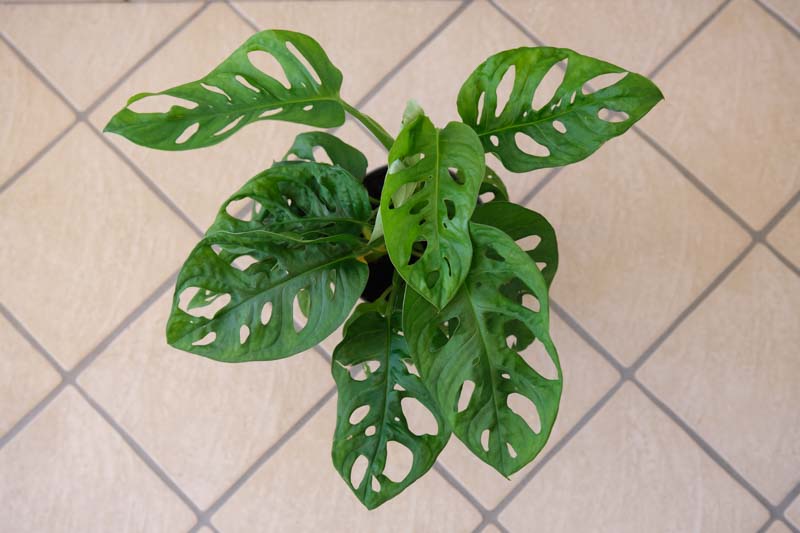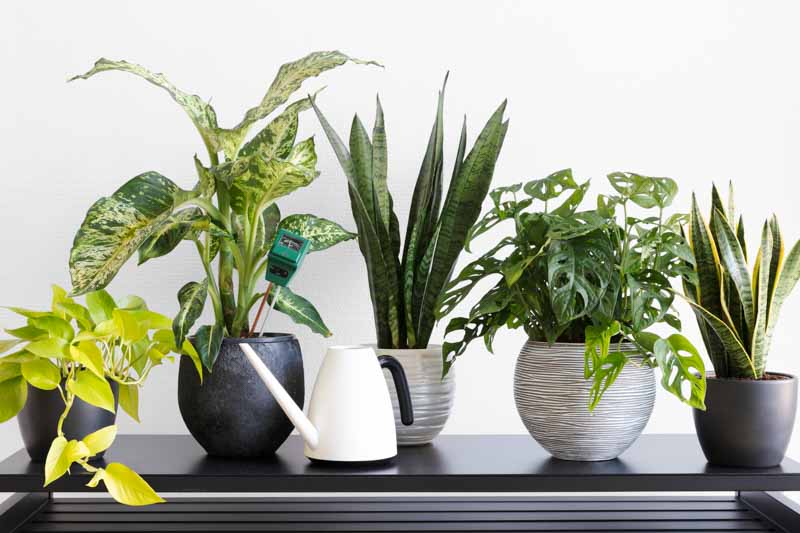Monstera obliqua, a plant shrouded in mystique and allure, stands out in the botanical world for its unique appearance. It is extremely rare and often confused with Monstera adansonii, which is more readily available.
Monstera obliqua is celebrated for its extraordinarily delicate and perforated leaves, which are more hole than leaf. This ethereal appearance distinguishes it from its cousin, Monstera adansonii, with the obliqua’s foliage being almost lace-like, showcasing a striking fenestration that captivates the eye.
Native: Native to the tropical forests of Central and South America, Monstera obliqua thrives under the canopy of dense jungles where humidity is high and light is dappled. Its presence spans several countries, including Peru, Brazil, and Bolivia. It belongs to the arum family (Araceae), along with Zantedeschia (Calla Lily), Caladium (Angel Wing), or Colocasia (Elephant Ear).
Plant Type and Habit: This is a slow-growing, evergreen trailing shrub. In the wild, it uses aerial roots to attach itself to larger trees, gradually climbing towards the canopy to access more light.
Size: When grown indoors, Monstera obliqua can reach up to 4-5 feet in height (120-150 cm) and 2-3 feet in spread (60-90 cm), depending on the support provided for its climbing habit. Outdoors, it can grow 6-10 feet tall (180-300 cm).
Foliage: The defining feature of Monstera obliqua is its dramatic foliage. The leaves are thin, almost transparent, and have more open space than leaf material due to the extensive fenestration. This unique trait makes the plant highly sought after among collectors.
Flowers: The plant produces inflorescences typical of the Araceae family, featuring a spadix surrounded by a creamy-yellow spathe. These flowers are a rare sight in domestic cultivation.
Hardiness: Monstera obliqua is hardy in USDA zones 10-12, thriving in warm, humid conditions.
Uses: Primarily, Monstera obliqua is cultivated for its ornamental value. Its unique appearance makes it a prized addition to indoor plant collections, greenhouses, and botanical gardens.
Toxicity: This plant is toxic to humans, cats, and dogs if ingested. It contains calcium oxalate crystals that can cause mouth and stomach irritation. Contact with the sap may cause skin irritation.
Deer and Rabbits: Its toxicity generally deters deer and rabbits.
Invasiveness: There is no evidence to suggest that Monstera obliqua is invasive. Its cultivation is primarily confined to controlled environments due to its specific care requirements and rarity.
Benefits: Aside from its breathtaking aesthetic value, Monstera obliqua can contribute to indoor air purification. Like many houseplants, it participates in removing pollutants from the air, albeit to a lesser extent due to its sparse foliage.

Growing and caring for Monstera, a striking tropical plant, is relatively straightforward, making it a popular choice for indoor gardeners.
Light: Monstera obliqua prefers bright, indirect sunlight to thrive. Direct sunlight can scorch its leaves, while too little light may reduce leaf perforations and growth. An east or west-facing window providing filtered light is ideal for this tropical plant.
Soil: Use a peat-based potting mix with perlite or sand to improve drainage. Monsteras prefer slightly acidic to neutral pH.
Water: Water when the top inch of soil feels dry. Monsteras like evenly moist soil but not soggy. Reduce watering in winter.
Temperature and Humidity: Ideal temperatures range from 68°F to 86°F (20°C to 30°C). Avoid exposure to temperatures below 50°F (10°C), as cold can damage the plant. Thrives in humidity levels of 80% or higher. Use a humidifier or mist the leaves regularly to increase humidity, especially in dry environments.
Fertilization: Apply a balanced, water-soluble fertilizer monthly during the growing season (spring through summer).
Pruning: Prune in spring or early summer to maintain size and shape. Remove any yellow or damaged leaves to encourage new growth.
Cleaning: Dust the leaves occasionally with a damp cloth to ensure the plant can photosynthesize efficiently. This also keeps the plant looking its best.
Repotting: Repot every 2-3 years or when the plant becomes rootbound. Choose a pot 1-2 inches larger in diameter than the current one.
Climbing Support: Provide a moss pole or trellis for support, mimicking its natural climbing habit. Attach stems loosely to the support as they grow.

Scindapsus aureum, Sansevieria laurentii, Monstera obliqua,Sansevieria zeylanica, Dieffenbachia
Propagating Monstera is a rewarding and straightforward process that allows you to create new plants from an existing one.
Monstera can encounter pests, diseases, and other common problems, especially when grown indoors.
Spider Mites: These tiny pests cause yellow stippling on leaves. Increase humidity and wash leaves with water or use insecticidal soap.
Mealybugs: Look for cottony deposits in leaf axils or undersides. Remove with alcohol-dipped cotton swabs or apply neem oil.
Aphids: Small, pear-shaped pests that cluster on new growth and undersides of leaves, sucking plant sap and weakening it. Combat them with a gentle spray of water, neem oil, or insecticidal soap to protect the plant’s health and appearance.
Scale insects: Hard, brown bumps on leaves/stems indicate scale. Scrape off manually and treat with neem oil or insecticidal soap.
Root rot: Overwatering can lead to root rot, characterized by mushy, brown roots and yellowing leaves. Ensure good drainage and allow soil to dry between waterings.
Leaf spot: Fungal or bacterial leaf spots appear as discolored patches on leaves. Improve air circulation, avoid wetting foliage, and treat with fungicides if severe.
Yellowing Leaves: Overwatering, poor drainage, or nutrient deficiencies can cause leaves to yellow. Adjust watering habits and consider repotting or fertilizing.
Brown Leaf Tips/Edges: Low humidity or drought stress might cause brown tips. Increase humidity around the plant with a pebble tray or humidifier.
Leggy Growth: Insufficient light can lead to sparse, leggy growth. Move your Monstera to a brighter location with indirect sunlight.
Fenestration Not Developing: Young plants or those not receiving enough light may not develop the characteristic leaf holes or splits. Provide brighter indirect light to encourage fenestration.
| Hardiness |
10 - 12 |
|---|---|
| Plant Type | Houseplants, Climbers, Shrubs |
| Plant Family | Araceae |
| Genus | Monstera |
| Exposure | Partial Sun |
| Season of Interest |
Spring (Early, Mid, Late) Summer (Early, Mid, Late) Fall Winter |
| Height |
4' - 10' (120cm - 3m) |
| Spread |
2' - 3' (60cm - 90cm) |
| Maintenance | Low |
| Water Needs | Average |
| Soil Type | Loam, Chalk, Clay, Sand |
| Soil pH | Acid, Neutral, Alkaline |
| Soil Drainage | Moist but Well-Drained |
| Characteristics | Showy, Evergreen |
| Tolerance | Deer, Rabbit |
| Garden Uses | Patio And Containers |
| Hardiness |
10 - 12 |
|---|---|
| Plant Type | Houseplants, Climbers, Shrubs |
| Plant Family | Araceae |
| Genus | Monstera |
| Exposure | Partial Sun |
| Season of Interest |
Spring (Early, Mid, Late) Summer (Early, Mid, Late) Fall Winter |
| Height |
4' - 10' (120cm - 3m) |
| Spread |
2' - 3' (60cm - 90cm) |
| Maintenance | Low |
| Water Needs | Average |
| Soil Type | Loam, Chalk, Clay, Sand |
| Soil pH | Acid, Neutral, Alkaline |
| Soil Drainage | Moist but Well-Drained |
| Characteristics | Showy, Evergreen |
| Tolerance | Deer, Rabbit |
| Garden Uses | Patio And Containers |
How many Monstera obliqua do I need for my garden?
| Plant | Quantity | |
|---|---|---|
| Monstera obliqua | N/A | Buy Plants |
Create a membership account to save your garden designs and to view them on any device.
Becoming a contributing member of Gardenia is easy and can be done in just a few minutes. If you provide us with your name, email address and the payment of a modest $25 annual membership fee, you will become a full member, enabling you to design and save up to 25 of your garden design ideas.
Join now and start creating your dream garden!
Create a membership account to save your garden designs and to view them on any device.
Becoming a contributing member of Gardenia is easy and can be done in just a few minutes. If you provide us with your name, email address and the payment of a modest $25 annual membership fee, you will become a full member, enabling you to design and save up to 25 of your garden design ideas.
Join now and start creating your dream garden!